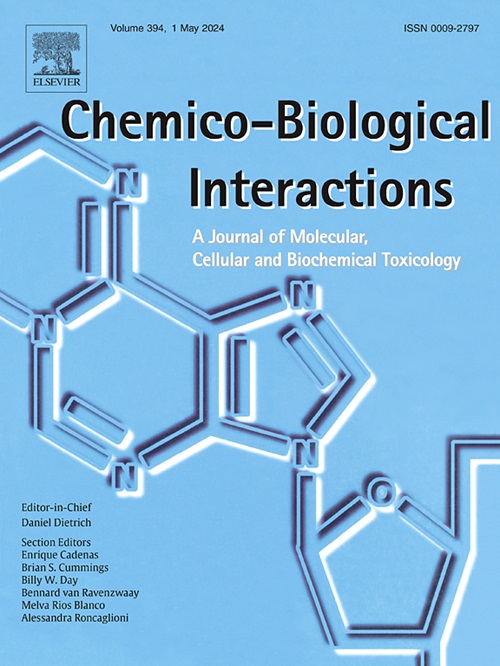Toxicokinetics and reproductive toxicity of maternal bisphenol AF exposure during gestation in offspring of Sprague Dawley rats
IF 4.7
2区 医学
Q1 BIOCHEMISTRY & MOLECULAR BIOLOGY
引用次数: 0
Abstract
Bisphenol AF (BPAF) has been widely used as a main alternative to bisphenol A (BPA), and previous in vitro studies have shown that BPAF has higher reproductive toxicity potentials than BPA. However, data on in vivo toxicity of BPAF is still limited. In this study, Sprague Dawley rats were exposed to BPAF (0, 50, and 100 mg/kg/day) during gestation to study toxicokinetics and reproductive toxicity in offspring. The results showed that plasma concentrations BPAF peaked within 6 h after birth, followed by a two-phase decay, with clearance rates of approximately 3.0 l/h and terminal half-life values ranging from 77 h to 114 h, suggesting fast absorption and high persistence of BPAF. At postnatal day 21 (PND21), BPAF was found to be bioaccumulated in reproductive organs (testes and ovaries) of the offspring, resulting in adverse effects on reproduction in both sexes. Lower anogenital distance, reduced relative testicular weight, dissolved interstitial cells, fewer primary spermatocytes, decreased testosterone levels, and increased luteinizing hormone levels were detected in male offspring. In female offspring, vacuolization in follicular antrum, fewer follicles, increased 17β-estradiol levels, and increased luteinizing hormone levels in female offspring were found. Gene expression of scavenger receptor class B type I (SR-B1), 3-hydroxy-3-methylglutaryl-CoA reductase (HMGR), sterol regulatory element-binding protein-1c (SREBP-1c), and several steroidogenic enzymes was significantly decreased in male offspring following maternal exposure to BPAF, suggesting that the decreases in testosterone levels is a result of inhibited cholesterol uptake, cholesterol de novo synthesis, and steroidogenesis. In addition, inhibition of pathways of phagosome and cell adhesion molecules might be the underlying molecular mechanism involved in BPAF-induced reproductive disorders in male offspring. This study provides the scientific basis for a comprehensive assessment of the safety of BPAF.

妊娠期母鼠双酚AF暴露对Sprague Dawley大鼠后代的毒性动力学和生殖毒性
双酚AF (BPAF)作为双酚a (BPA)的主要替代品被广泛使用,以往的体外研究表明,BPAF具有比BPA更高的生殖毒性潜能。然而,关于BPAF体内毒性的数据仍然有限。在本研究中,Sprague Dawley大鼠在妊娠期间暴露于BPAF(0、50和100 mg/kg/d),研究其后代的毒性动力学和生殖毒性。结果表明,BPAF的血药浓度在出生后6 h内达到峰值,随后呈两相衰减,清除率约为3.0 l/h,终末半衰期为77 ~ 114 h,表明BPAF的吸收速度快,持久性强。在出生后第21天(PND21), BPAF被发现在后代的生殖器官(睾丸和卵巢)中生物积累,对两性的生殖产生不利影响。在雄性后代中检测到肛门生殖器距离较短,睾丸相对重量减少,间质细胞溶解,初级精母细胞减少,睾酮水平降低,黄体生成素水平升高。雌性子代卵泡腔空泡化,卵泡减少,17β-雌二醇水平升高,黄体生成素水平升高。雌性暴露于BPAF后,雄性后代的清除受体B类I型(SR-B1)、3-羟基-3-甲基戊二酰辅酶a还原酶(HMGR)、甾醇调节元件结合蛋白1c (SREBP-1c)和几种甾体生成酶的基因表达显著降低,表明睾酮水平的降低是由于胆固醇摄取、胆固醇新生合成和甾体生成受到抑制。此外,抑制吞噬体和细胞粘附分子通路可能是bpaf诱导雄性后代生殖障碍的潜在分子机制。本研究为全面评价BPAF的安全性提供了科学依据。
本文章由计算机程序翻译,如有差异,请以英文原文为准。
求助全文
约1分钟内获得全文
求助全文
来源期刊
CiteScore
7.70
自引率
3.90%
发文量
410
审稿时长
36 days
期刊介绍:
Chemico-Biological Interactions publishes research reports and review articles that examine the molecular, cellular, and/or biochemical basis of toxicologically relevant outcomes. Special emphasis is placed on toxicological mechanisms associated with interactions between chemicals and biological systems. Outcomes may include all traditional endpoints caused by synthetic or naturally occurring chemicals, both in vivo and in vitro. Endpoints of interest include, but are not limited to carcinogenesis, mutagenesis, respiratory toxicology, neurotoxicology, reproductive and developmental toxicology, and immunotoxicology.

 求助内容:
求助内容: 应助结果提醒方式:
应助结果提醒方式:


